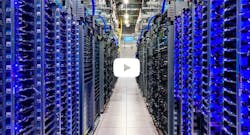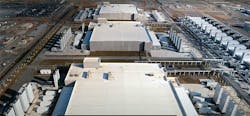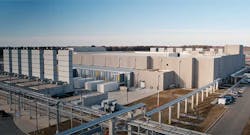Google doesn’t like to let people inside its data centers. But it DOES like to make its customers feel secure about the privacy and safety of its data. That’s why every few years, Google provides a video that provides an overview of its data center security – which also offers brief glimpses of the company’s facilities and technology for the data center nerds of the world (raising my hand here).
Google has just published the 2020 video update of its security protocols, featuring a walk-through of a data center by Google Developer Advocate Stephanie Wong. Most of the tour is focused on physical security, but there is some footage from within the data hall, featuring Google data center executive Joe Kava, as well as view of the buildings and campus. Here’s the video:
Google has long sought to protect the intellectual property of its innovations, while acknowledging public interest in the cool factor around its massive Internet infrastructure. That effort included industry conferences at the Googleplex in 2009 and in Zurich in 2011 that discussed its technology and best practices, and in 2012 the company published professional photos of its global fleet of data centers. With the launch of Google Cloud Platform, the company has released videos in 2014 and 2016, plus a video of a presentation by Kava at Cloud Next 2019.
What’s interesting from the new video? Keep in mind that Google’s data center design is continuously being updated to integrate new technologies and innovations, as well as refinements in design and operations.
An overhead view shows how Google approaches campus design, with multiple data center buildings with an identical size and shape, providing a repeatable design that can be used to easily add capacity in defined chunks that optimize capital deployment.
Some elements of the mechanical infrastructure are connected or adjacent to the building, with other elements placed slightly further away. This supports an approach in which all of the floor space within the data hall is dedicated to housing racks, servers, storage and networking equipment.
There’s very little equipment on the roof on this campus, an approach which limits the number of roof penetrations for cabling or piping, which can create the potential for leaks during rainy periods. Google is known to use rooftop equipment in markets with limited availability of real estate, such as Singapore, where the company builds multi-story data centers.
An overhead view of data center buildings on a Google campus. (Image: Google)
Here we see an exterior view of one of the data center buildings, which shows the raised trackways that support conduit and piping, presumably for utilities to support Google’s operations. In many data centers, these type of conduits are buried.
A Google data center building. (Image: Google)
Innovation is hard to discern from exterior photos. But these vertical structures that are visible alongside both the data center and the external mechanical equipment are a feature that we haven’t seen elsewhere, and we suspect they reflect a design innovation. They seem to be positioned near backup generators and power infrastructure, so this could be for emissions management or a heat recapture system.
A wide view of a Google data center campus. (Image: Google)
Enjoy the video. What’s seems interesting to you? Feel free to share your observations in the comments.
About the Author





